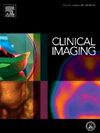MRI-derived radiomics and end-to-end deep learning models for predicting glioma ATRX status: a systematic review and meta-analysis of diagnostic test accuracy studies
IF 1.8
4区 医学
Q3 RADIOLOGY, NUCLEAR MEDICINE & MEDICAL IMAGING
引用次数: 0
Abstract
We aimed to systematically review and meta-analyze the predictive value of magnetic resonance imaging (MRI)-derived radiomics/end-to-end deep learning (DL) models in predicting glioma alpha thalassemia/mental retardation syndrome X-linked (ATRX) status. We conducted a comprehensive search across four major databases—Web of Science, PubMed, Scopus, and Embase. All the studies that assessed the performance of radiomics and/or end-to-end DL models for predicting glioma ATRX status were included. Quality assessment was performed using the Quality Assessment of Diagnostic Accuracy Studies-2 (QUADAS-2) criteria and the METhodological RadiomICs Score (METRICS). Pooled estimates for performance metrics were calculated. I-squared was used to assess heterogeneity, while subgroup and sensitivity analyses were performed to find its potential sources. Publication bias was assessed using Deeks' funnel plots. Seventeen and eleven studies were included in the systematic review and meta-analysis, respectively. Most of the studies had a low risk of bias and low concern for applicability according to the QUADAS-2. Also, most of them had good quality according to the METRICS. Meta-analysis showed a pooled sensitivity of 0.80 (95%CI: 0.71–0.96), a specificity of 0.82 (95%CI: 0.67–0.93), a positive diagnostic likelihood ratio (DLR) of 6.77 (95%CI: 4.67–9.82), a negative DLR of 0.15 (95%CI: 0.06–0.38), a diagnostic odds ratio of 30.36 (95%CI: 15.87–58.05), and an area under the curve (AUC) of 0.92 (95%CI: 0.89–0.94). Subgroup analysis revealed significant intergroup differences based on several factors. Radiomics models can accurately predict ATRX status in gliomas, enhancing non-invasive tumor characterization and guiding treatment strategies.
预测胶质瘤ATRX状态的mri衍生放射组学和端到端深度学习模型:诊断测试准确性研究的系统回顾和荟萃分析。
我们旨在系统回顾和荟萃分析磁共振成像(MRI)衍生放射组学/端到端深度学习(DL)模型在预测神经胶质瘤α地中海贫血/智力迟钝综合征x连锁(ATRX)状态方面的预测价值。我们在四个主要数据库——web of Science、PubMed、Scopus和Embase中进行了全面的搜索。所有评估放射组学和/或端到端DL模型预测胶质瘤ATRX状态的研究都被纳入其中。采用诊断准确性研究质量评估-2 (QUADAS-2)标准和方法学放射组学评分(METRICS)进行质量评估。计算了性能指标的汇总估计。使用i平方来评估异质性,同时进行亚组分析和敏感性分析以寻找其潜在来源。采用Deeks漏斗图评估发表偏倚。系统评价和荟萃分析分别纳入了17项和11项研究。根据QUADAS-2,大多数研究具有低偏倚风险和低适用性关注。此外,根据METRICS,它们中的大多数都具有良好的质量。meta分析显示,合并敏感性为0.80 (95%CI: 0.71 ~ 0.96),特异性为0.82 (95%CI: 0.67 ~ 0.93),阳性诊断似然比(DLR)为6.77 (95%CI: 4.67 ~ 9.82),阴性诊断似然比(DLR)为0.15 (95%CI: 0.06 ~ 0.38),诊断优势比为30.36 (95%CI: 15.87 ~ 58.05),曲线下面积(AUC)为0.92 (95%CI: 0.89 ~ 0.94)。亚组分析显示基于几个因素的显著组间差异。放射组学模型可以准确预测胶质瘤中ATRX的状态,增强肿瘤的非侵入性表征,指导治疗策略。
本文章由计算机程序翻译,如有差异,请以英文原文为准。
求助全文
约1分钟内获得全文
求助全文
来源期刊

Clinical Imaging
医学-核医学
CiteScore
4.60
自引率
0.00%
发文量
265
审稿时长
35 days
期刊介绍:
The mission of Clinical Imaging is to publish, in a timely manner, the very best radiology research from the United States and around the world with special attention to the impact of medical imaging on patient care. The journal''s publications cover all imaging modalities, radiology issues related to patients, policy and practice improvements, and clinically-oriented imaging physics and informatics. The journal is a valuable resource for practicing radiologists, radiologists-in-training and other clinicians with an interest in imaging. Papers are carefully peer-reviewed and selected by our experienced subject editors who are leading experts spanning the range of imaging sub-specialties, which include:
-Body Imaging-
Breast Imaging-
Cardiothoracic Imaging-
Imaging Physics and Informatics-
Molecular Imaging and Nuclear Medicine-
Musculoskeletal and Emergency Imaging-
Neuroradiology-
Practice, Policy & Education-
Pediatric Imaging-
Vascular and Interventional Radiology
 求助内容:
求助内容: 应助结果提醒方式:
应助结果提醒方式:


